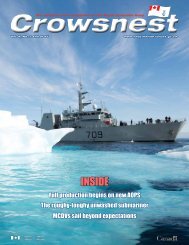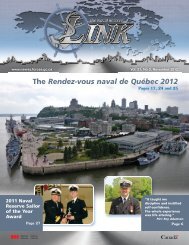You also want an ePaper? Increase the reach of your titles
YUMPU automatically turns print PDFs into web optimized ePapers that Google loves.
5 Mitigating <strong>the</strong> Challenges<br />
<strong>Maritime</strong> security is more than just about <strong>the</strong> sea. It embraces a range <strong>of</strong> maritime-related<br />
activities that pose risks <strong>and</strong>/or threats to states’ territorial security interests. 298 <strong>The</strong> responses are<br />
equally broad, <strong>and</strong> include both national <strong>and</strong> international approaches to <strong>the</strong> problem. Nationally,<br />
this is evident in recent decisions by governments to enhance <strong>the</strong>ir maritime domain awareness by<br />
dedicating increased resources for air-, sea-, <strong>and</strong> space-based platforms <strong>and</strong> sensors. 299 For<br />
countries with large ocean estates (e.g., Canada, Russia, <strong>the</strong> US, Australia, India <strong>and</strong> Indonesia)<br />
<strong>the</strong> challenge is monumental <strong>and</strong> will be a work in progress for many years, if not decades. It will<br />
dem<strong>and</strong> vast resources <strong>and</strong> is beyond <strong>the</strong> ability <strong>of</strong> a single agency—a navy or a coast guard—to<br />
tackle successfully. Some strategy documents—Canada’s <strong>Maritime</strong> Domain Awareness Strategy<br />
(2011), <strong>the</strong> UK National Strategy for <strong>Maritime</strong> Security (2014), Washington’s Presidential Policy<br />
Directive 18: National Strategy for <strong>Maritime</strong> Security (2012) <strong>and</strong> National <strong>Maritime</strong> Domain<br />
Awareness Plan (2013), as well as <strong>the</strong> EU <strong>Maritime</strong> Security Strategy (2014)—explicitly<br />
acknowledge that maritime security requires a whole-<strong>of</strong>-government response.<br />
How governments will respond to <strong>the</strong>ir own national maritime security needs will be informed by<br />
strategic cultures, more immediate political assessments, <strong>and</strong> available resources. For some<br />
countries, particularly those traditionally sensitive about national security, a more narrow national<br />
approach, measured against <strong>the</strong> capability <strong>of</strong> o<strong>the</strong>r states, will be viewed as most appropriate.<br />
Russia’s maritime doctrine (2001) is a case in point. It is intended “to implement <strong>and</strong> protect <strong>the</strong><br />
interests <strong>of</strong> <strong>the</strong> Russian Federation in <strong>the</strong> oceans <strong>and</strong> <strong>the</strong> streng<strong>the</strong>ning <strong>of</strong> <strong>the</strong> position <strong>of</strong> <strong>the</strong><br />
Russian Federation among <strong>the</strong> leading maritime nations.” 300 Where distrust <strong>of</strong> neighbours is<br />
widespread but resources are scant, individual countries’ maritime security needs will obviously<br />
not be met, even if ambitious objectives underscore a government’s priorities. For example, <strong>the</strong><br />
“five pillars” <strong>of</strong> Indonesia’s maritime doctrine (November 2014) underst<strong>and</strong>ably reflect concerns<br />
about <strong>the</strong> safety <strong>of</strong> seaborne trade routes through <strong>the</strong> country’s waters as well as protection <strong>of</strong> its<br />
marine resources. 301 Alternatively, <strong>the</strong> Canada-US Beyond <strong>the</strong> Border Initiative (2011) builds<br />
upon a longst<strong>and</strong>ing <strong>and</strong> relatively transparent bilateral defence relationship. In acknowledging<br />
that <strong>the</strong>ir security <strong>and</strong> economies are symbiotically connected, Washington <strong>and</strong> Ottawa have<br />
adopted a continental approach to maritime domain awareness, identifying creating a process to<br />
jointly address problem areas. 302 That decision reflects an even earlier determination to exp<strong>and</strong><br />
<strong>the</strong> m<strong>and</strong>ate <strong>of</strong> <strong>the</strong> North American Aerospace Defence Comm<strong>and</strong> to include a maritime warning<br />
dimension.<br />
298 Klein, <strong>Maritime</strong> Security <strong>and</strong> <strong>the</strong> Law <strong>of</strong> <strong>the</strong> Sea, p. 4.<br />
299 <strong>Maritime</strong> Domain Awareness can be defined as “having true <strong>and</strong> timely information about everything<br />
on, under, related to, adjacent to, or bordering a sea, ocean or o<strong>the</strong>r navigable waterway. This includes all<br />
related activities, infrastructure, people, cargo, vessels, or o<strong>the</strong>r means <strong>of</strong> transport.” This definition is<br />
found at Transport Canada, <strong>Maritime</strong> Domain Awareness [accessed on 10 May 2015 at<br />
www.tc.gc.ca/eng/marinesecurity/initiatives-235.htm].<br />
300 President <strong>of</strong> <strong>the</strong> Russian Federation, <strong>Maritime</strong> Doctrine <strong>of</strong> <strong>the</strong> Russian Federation 2020 (Moscow,<br />
2001), p. 3.<br />
301 Kessing’s Record <strong>of</strong> World Events, Vol. 609, No. 11, 2014, p. 53692.<br />
302 Government <strong>of</strong> Canada, Beyond <strong>the</strong> Border: A Shared Vision for Perimeter Security <strong>and</strong> Economic<br />
Competitiveness (Ottawa, 2011), p. 5.<br />
DRDC-RDDC-2016-R085 63




